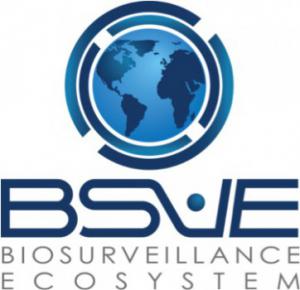BiosurveillanceCloud-based biosurveillance ecosystem
The Departments of Defense and Homeland Security are developing a system which lets epidemiologists scan the planet for anomalies in human and animal disease prevalence, warn of coming pandemics, and protect soldiers and others worldwide.

Cloud- based biosurveillance ecosystem logo // Source: dodlive mil
The Departments of Defense and Homeland Security are developing a system which lets epidemiologists scan the planet for anomalies in human and animal disease prevalence, warn of coming pandemics, and protect soldiers and others worldwide.
The Biosurveillance Ecosystem, or BSVE, is a program of DoD’s Defense Threat Reduction Agency’s (DTRA) Joint Science and Technology Office for Chemical and Biological Defense, or JSTO-CBD, the Joint Program Executive Office for Chemical and Biological Defense and Homeland Security’s National Biosurveillance Integration Center.
DoD News discussed the BSVE with DTRA scientists Dr. Christopher M. Kiley and Dr. John Hannan.
Biosurveillance ecosystem
The BSVE is a virtual, customizable, collaborative system that uses commercial and government technologies to aggregate and analyze data streams, Kiley said.
“The BSVE ingests a wide variety of data sources — open-source data, social media and diagnostic data, and DoD, interagency, national and international surveillance system data,” he added.
Analytic applications and user-designed apps in the BSVE use the aggregated data streams to provide near-real-time modeling, analyses and visualized results, Kiley said.
The BSVE provides automated, intelligently suggested data, tools and analyses, and a user-friendly interface with modern collaboration and reporting features.
While the environment is still in development, Kiley said, “The BSVE exists. We have users on the system providing us feedback.”
Open-source approach
Kiley and Hannan said the BSVE is being developed using open-source software and systems that allow easier integration, increased transparency for a broader user base and customizability.
“The BSVE ingests and uses large data streams such as open-source social media feeds, RSS feeds from news organizations and blogs, disease ontologies, de-identified diagnostic results, historic outbreak data, zoonotic data and non-health data,” Kiley said.
The system also uses machine learning and natural-language processing algorithms intelligently to identify aberrations in disease signals, he added.
Sources include the World Health Organization and its many public health and infectious disease networks, the United Nations Food and Agriculture Organization, the World Organization for Animal Health and many more, Kiley said.
Another source is the Program for Monitoring Emerging Diseases, or ProMED Mail, he said, an Internet e-mail service of the International Society for Infectious Diseases used by scientists, physicians, veterinarians, epidemiologists, public health professionals and anyone interested in infectious diseases.